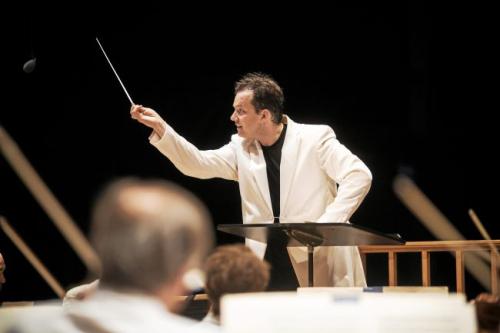Nelsons, BSO return to Mahler 9 with even greater depth at Tanglewood

Andris Nelsons led the Boston Symphony Orchestra in Mahler’s Symphony No. 9 Friday night at Tanglewood.
For Andris Nelsons and the Boston Symphony Orchestra, performances of Mahler’s Ninth Symphony have been special occasions.
In a BSO concert at Carnegie Hall in March 2011, Nelsons, then 32, filled in at the last minute for an ailing James Levine to conduct the work. The resulting music, heralded for its focus and command of detail, laid the foundations for what would become a fruitful partnership between the young conductor and the orchestra.
Nelsons and the BSO returned to the symphony this past April, and the performance reflected a deepened maturity with the music. Less focused on controlling every detail, Nelsons seemed to let the music form naturally in mid air, and, thus, allow it to speak for itself.
Friday night at Tanglewood’s Koussevitzky Shed, Mahler’s majestic Ninth Symphony received an even more profound rendering as Nelsons led the BSO in the ninety-minute work.
Completed in 1909, the Ninth Symphony reflects a tumultuous time in Mahler’s life. His eldest daughter had recently died from scarlet fever and the composer was diagnosed with a life-threatening heart condition. The work, for these reasons, has come to symbolize a farewell to life.
Each movement is a world unto itself. The first traverses from peaceful, sighing gestures to passages of powerful intensity. Instrumental lines bristle against one another, colliding rather than blending. Chamber-like textures also dot the movement, with a solo French horn– performed expertly by James Sommerville– soaring over dark, primordial chords in the winds and strings.
The second movement is filled with colorful effects, the music afire with snarling brass and burbling woodwind figures. The Rondo-Burleske, with its slithery counterpoint, seems to look ahead to the modernism of Shostakovich, who was an admirer of Mahler’s work.
The most beautiful music comes in the finale. The closing bars sound on the edge of a whisper and float heavenward. As Steven Ledbetter put it in his program notes, Mahler was holding on.
Nelsons led a resplendent performance of this astounding work. Directed with waving gestures, he crafted the lines in great, arching paragraphs with a nod to the finer details of the score. The orchestra responded beautifully. The Ländler of the second movement had equal parts sly humor and bucolic verve, while the Rondo-Burleske sounded with an edge-of-the-seat urgency, spotlighting stellar contributions from the brass. Trumpeter Thomas Rolfs floated a gorgeous solo in the movement’s central section. The most affecting playing, though, came in the finale, where the string phrases coalesced in glowing sheets of sound.
The concert opened with Mozart’s Piano Concerto No. 27 in B-flat, K. 595, with Jonathan Biss as soloist.
Over the past decade, Biss has become one of the most dynamic pianists on the scene today through his interpretations of Beethoven and Schumann as well as for his advocacy of new music.
He is a graceful Mozartean, and while his playing Friday night didn’t have the sparkle of a Mozart purist like Robert Levin, Biss conveyed the concerto’s phrases with a sound of plush warmth.
That was especially the case in the second movement, where Biss performed the theme with spacious phrasing. He handled the opening movement with fine touch, and even the frolicking lines of the finale had a delicate softness to the sound.
On the podium, Nelsons guided an accompaniment that was awash in bold colors, with the precision-cut passages sounding plump in the strings and winds. Here too, a chamber-like sensitivity was the hallmark as Biss’ piano meshed sveltely with string trio and solo flute.
Andris Nelsons will lead the Boston Symphony Orchestra in music by Corigliano, Beethoven, and Sibelius 8 p.m. Saturday at the Koussevitzky Shed. bso.org; 888-266-1200.
Posted in Performances




